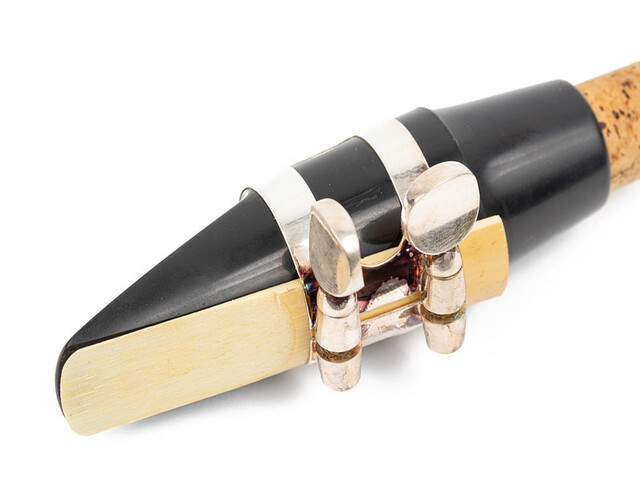If you play the saxophone or the clarinet, you know oftentime players double on the other. With the cost of good reeds and how frequently they need replaced, you may wonder if reeds are interchangeable between the two instruments.
Reeds are specifically designed for the instrument they are intended for, and using them on alternate instruments will affect the sound quality and playability of the instrument. It is best not to use clarinet reeds on saxophone or vice versa to maintain optimum performance of the instrument.
However, because there are clarinet and saxophone mouthpieces of similar sizes, it is possible to use specific reeds interchangeably.
Players may do so in a crunch or to get a unique tone on one of the instruments, but there are limitations to which reeds are able to be used on the non-intended instrument.
Interchangeable Reed Matches:
| Saxophone | Clarinet |
| Soprano saxophone | Bb (soprano) clarinet |
| Alto saxophone | Alto clarinet |
| Tenor saxophone | Bass clarinet |
| Baritone saxophone | Contra-alto clarinetContra-bass clarinet (smaller mouthpiece) |
Table of Contents
Will an alto sax reed work on alto clarinet?

Alto saxophone reeds will work on the alto clarinet and are often substituted when alto clarinet reeds are not available. Alto clarinet reeds can be difficult to find in store.
Some players find it easier to play the alto clarinet with the alto sax reed due to the clarinet reed being stiffer than a sax reed of the same size and strength.
The reverse will also work, so alto clarinet reeds and alto saxophone reeds are basically interchangeable. They are usually the same size and length, making it a simple exchange.
Can a sax reed work on a bass clarinet?
Tenor saxophone reeds will work on the bass clarinet, and there are players who prefer to use them instead of bass clarinet reeds.
The sax reed offers more flexibility and volume which is desired in modern music. Orchestral music, however, typically requires softer sounds, so a clarinet reed is generally a better fit.
Some brands of tenor sax reeds produce longer reeds, so the size of the mouthpiece of the bass clarinet is an important factor for the fit. If needed, however, the end of the sax reed can be cut to the proper size.
A bass clarinet fitted with a tenor saxophone reed will often produce a good sound for jazz music. To some people, tenor saxophone reeds produce a more “reedy” sound on clarinet. They are also typically more affordable than clarinet reeds.
Jazz saxophonist John Surman uses tenor sax reeds on his bass clarinet.
Can you use a baritone sax reed on a clarinet?
Because of the similar width and length, baritone saxophone reeds work on contra-alto clarinets.
Baritone sax reeds are more widely available and are often used as a substitute because of the limited availability of contra-alto clarinet reeds. There are brands of reeds that do not offer contra-alto clarinet reeds at all.
It is also possible to use a bari sax reed on the contrabass clarinet if the mouthpiece of the clarinet is on the smaller size. It may not be an optimal setup but it is much cheaper.
Bass clarinet reed for the sax?
Bass clarinet reeds work for tenor saxophones.
The bass clarinet reeds are slightly shorter and have a larger heart which helps the altissimo range of the tenor sax stay consistent and clear. This is helpful because this range of the tenor sax tends to cut out.
Tenor sax and bass clarinet reeds are made from the same size blanks, however the thickness varies in some brands. To some players, the sax reed plays harsher.
Lenny Pickett, the musical director of the Saturday Night Live band, swears by bass clarinet reeds on tenor sax.
Clarinet reed on soprano sax?
Reeds for the Bb clarinet can be used for the soprano saxophone. The clarinet reed produces a more vibrant and full tone, and better projection.
Additional benefits to this reed swap are more control in the altissimo range and a higher percentage of good reeds per box.
The clarinet reed is narrower, so the player may need time to adjust to the size in comparison to soprano sax reeds. The intonation will push sharper in the lower register of the soprano sax with this reed.
Saxophonist Branford Marsalis has been heard stating that he plays clarinet reeds on soprano because he likes the cut.
Reed cut and mouthpiece for clarinet vs saxophone

To help you decide whether a clarinet or saxophone reed is best for your instrument, there are a few specifics to consider.
The first thing to consider in finding the right reed is to ensure the best fit for your mouthpiece.
Reed Cuts
Reeds come in two cuts typically: filed and unfiled. A file cut reed, also known as French cut, has a faster response time with a V-shaped heart. They are more suited to classical music and darker sounding mouthpieces.
The unfiled cut reed, also known as standard or American cut, has a less defined, u-shape to the heart of the reed and is more suited to jazz. This cut fits well with a brighter sounding mouthpiece.
If using a saxophone reed on a clarinet to obtain more flexibility, a filed reed works well. If using a clarinet reed on the saxophone for brighter tone and clarity, the unfiled reed is a great choice.
Also, the strength of the reed can influence the sound. Clarinet reeds are generally harder than saxophone reeds of the same strength level, so you may need to go up or down a level when making a switch.
Clarinet reeds tend to be longer than their saxophone counterparts. They also have a denser heart, which is why clarinet reeds are typically less flexible than saxophone reeds.
In general, clarinet reeds are more expensive and limited in selection while saxophone reeds are more widely available and offer more options of brands and styles.
Be mindful that reed lengths can vary between brands. Also, reeds of the same exact box can vary slightly.
Mouthpiece
The mouthpiece plays a major role in choosing the best reed for your instrument. Regardless of whether interchanging saxophone and clarinet reeds, the reed and mouthpiece should be matched in regards to proper length and width.
The baffle, tip opening, and length of the mouthpiece will affect which reed cut and strength work. The geometry of the mouthpiece will influence the brightness or darkness of its tone.
The baffle is the section of the mouthpiece toward the top, right after the tip. Its shape and height have a large impact on your sound because it is the first thing the sound hits.
The tip opening and facing length should be taken into account when matching the right reed to any instrument. They are highly pertinent when crossing reeds between clarinet and saxophone due to varying lengths and hardness of reeds.
Synthetic Reeds for clarinet and/or saxophone
Legere makes specialty synthetic reeds that can be used on multiple instruments. They offer unique reed cuts and profiles that may fit certain mouthpieces better than cane. They are also more durable.
The Legere Signature European clarinet reeds are the same as Legere Signature soprano sax reeds, just a bit longer. They are wide for a clarinet reed, making them a potential match for saxophone mouthpieces.
Synthetic reeds do cost significantly more, however they are much longer-lasting than their cane reed counterparts. They last up to a year, while cane reeds have to be replaced at around two weeks of use, depending on how much they are used.
Should you cross reeds between clarinet and saxophone?
While it is possible to interchange reeds, purists will tell you to always use the right tool for the job.
Using a reed interchangeably long-term will eventually prevent mastery of the instrument’s true range and tone because reeds are created to be instrument specific.
If you decide to experiment with crossing reeds, remember to take into consideration how the mouthpiece, ligature, and reed fit each other.
There are methods for cutting, filing, shaving, and adjusting reeds so they fit properly and produce the desired sound.
Many players report better results to getting a bigger sound and projection when using saxophone reeds on clarinets when the reed cut and mouthpiece are matched.
However, when interchanging reeds, the player may need to adjust for intonation issues in certain ranges.
The style of music, desired tone, and individual preference, also play roles in deciding whether to use a clarinet reed for sax or vice versa. Many saxophonists and clarinetists agree that if it sounds right, it is right.
Experiences vary, so it may take some trial and error to see what reeds work for your situation. Every player is unique, and the advantages to crossing reeds boils down to what kind of sound you desire.
***
Photo credits:
Featured image: “Bardentreffen_2010_ 1518” (CC BY 2.0) by rs-foto
(2) “Clarinet Reeds” (CC BY-SA 2.0) by APMus
(3) “Golden Metal Saxophone Neck with Mouthpi” (CC BY 2.0) by wuestenigel

